University Communications and Marketing
Project puts MSUB plant collection into the digital domain
February 25, 2010
Contacts:
Dr. Tasneem Khaleel, College of Arts and Sciences, 657-2177
Herbarium of 16,000 specimens will soon be available to wider audience
MSU BILLINGS NEWS SERVICES — For a biologist in training, Aaron Snyder sure has been spending a lot of time lately doing history.
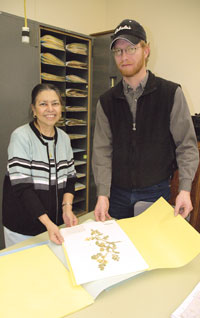
In fact, the Montana State University Billings student has been up to his elbows with old Montana phlox, prairie grass and other plants. He is spending time through the winter and spring connecting the past with the future by contributing plant information housed at MSU Billings to a national database of all vascular plants from the Missouri River plateau.
“I’m really enjoying it,” said Snyder, a junior biology student from Bozeman who eventually wants to become a science teacher. “At first I didn’t know how it would be, but it’s been interesting.”
Leafing through large folders yellowed by time, Snyder checks plants that had been pressed by flat and preserved when Montana was essentially in its infancy. Some collected items date back to before World War I while others were collected for early U.S. Forest Service projects in the 1930s, ’40s and mid 20th century.
Snyder’s work is being funded by a National Science Foundation grant that MSU Billings received through collaboration with Black Hills State University in South Dakota. The $7,000 grant is being used to keep Snyder employed through the summer so he can comb through plant species on file at the university and see which ones fit into the Missouri Plateau database.
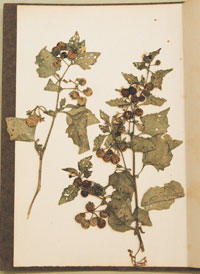 At the center of the project is the university’s herbarium, a collection of preserved
plant species that sits in a series of corner lockers at the MSU Billings science
building. The herbarium is a major point of pride of and overseen by Dr. Tasneem Khaleel,
a botanist and current dean of the College of Arts and Sciences.
At the center of the project is the university’s herbarium, a collection of preserved
plant species that sits in a series of corner lockers at the MSU Billings science
building. The herbarium is a major point of pride of and overseen by Dr. Tasneem Khaleel,
a botanist and current dean of the College of Arts and Sciences.
“The first grant I wrote was for the cabinets for this herbarium,” Khaleel notes as she and Snyder took a look recently at some of the preserved plants.
Nearly a secret to everyone other than scientists, students and maybe a few amateur botanists, the herbarium is treasure trove of plant species from Eastern Montana as well as Khaleel’s native India. Growing comfortably and steadily like prairie grass in the corner of a lab in the Science Building, the herbarium is registered in “Index Herbariorum” a global directory of public herbaria.
The MSU Billings herbarium has specimens that serve as a tool for basic research in plant systematics, ecology, phytogeography and plant evolution. The collection is used in teaching and research as a resource to provide population localities for studies ranging from biological control to rare plants. It was originally established in 1976 when Khaleel came to what was then Eastern Montana College. Once established, it consolidated the collections from EMC and the former Eastern Montana Normal School, Rocky Mountain College and the local office of the Forest Service.
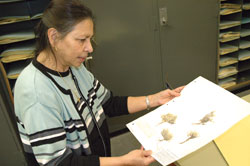 It now contains about 16,000 specimens and includes plants of Montana (with specific
emphasis on Eastern Montana and the Beartooth Plateau) as well as some gathered from
India, Venezuela, Texas, Wisconsin, Ohio and Utah.
It now contains about 16,000 specimens and includes plants of Montana (with specific
emphasis on Eastern Montana and the Beartooth Plateau) as well as some gathered from
India, Venezuela, Texas, Wisconsin, Ohio and Utah.
Proudly showing off some of the dried specimens from a tall closet, Khaleel talks about how the herbarium is organized and maintained for teaching and research purposes. Files and folders contain not only dried plants, but snippets of history.
They tell tales of time and place in shades of ashen green and brown. Take for example a plant plucked from central Montana just 25 years after statehood. The label bears the name of phlox hoodii and it says it was collected by a “H.M. Crane” somewhere in the hills of Meagher County in May 1914. The documentation says it was collected in the 5,500 foot elevation that year by the Forest Service and then removed from a collection owned by someone named Mae Martin.
All that is good for research purposes and it may very well match a similar plant found elsewhere in the upper Missouri River region, but unless a researcher treks to Billings and takes the time to do the investigation, that kind of knowledge remains dormant.
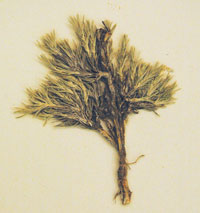 That’s where Snyder’s work comes in.
That’s where Snyder’s work comes in.
Painstakingly, he is cross-referencing the information in the MSU Billings herbarium with a national database. Now, when a researcher from Minnesota is double-checking similar plant life across the northern plains, the Mae Martin’s phlox from Meagher County can be confirmed as having had that specimen.
It’s a way to connect botanical history across time and the plains.
According to researchers who developed the grant from Black Hills State University, the region comprising the Missouri Plateau (also known as the Northwestern Great Plains and Northwestern Glaciated Plains) is not well known botanically even though the area consists of approximately 1/12th of the land area in the 48 contiguous states.
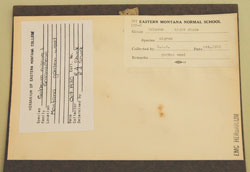 Even though there are pockets of information across the plains, there is not an accessible
electronic database for the plants of the area, although there are three web-accessible
sites representing smaller portions of the Missouri Plateau. The existing collections
are divided among numerous herbaria, most of which are not often visited by scientists.
Even though there are pockets of information across the plains, there is not an accessible
electronic database for the plants of the area, although there are three web-accessible
sites representing smaller portions of the Missouri Plateau. The existing collections
are divided among numerous herbaria, most of which are not often visited by scientists.
Specific objectives of this project include:
- Develop a database of all vascular plants from the Missouri Plateau (MP) held by 14 herbaria in the region; and
- Provide web access to data for plants from the region.
The project will make knowledge of the flora of the area more accessible to researchers, land managers and the general public, Khaleel said, and will increase research use of the collections from around the region.
“This will allow researchers to access all of this from their desktop,” she said. “Before now, sharing these specimens was like sending away a book of which you only have one copy.”
TOP PHOTO ABOVE: Dr. Tasneem Khaleel and student Aaron Snyder with one of the plant specimens that is part of the herbarium at MSU Billings.
